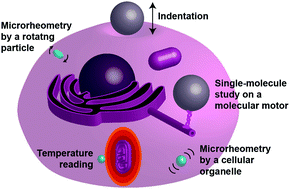当前位置:
X-MOL 学术
›
J. Mater. Chem. B
›
论文详情
Our official English website, www.x-mol.net, welcomes your
feedback! (Note: you will need to create a separate account there.)
Optical trapping for biosensing: materials and applications
Journal of Materials Chemistry B ( IF 6.1 ) Pub Date : 2017-11-01 00:00:00 , DOI: 10.1039/c7tb01921a P. Rodríguez-Sevilla 1, 2, 3, 4, 5 , L. Labrador-Páez 1, 2, 3, 4, 5 , D. Jaque 1, 2, 3, 4, 5 , P. Haro-González 1, 2, 3, 4, 5
Journal of Materials Chemistry B ( IF 6.1 ) Pub Date : 2017-11-01 00:00:00 , DOI: 10.1039/c7tb01921a P. Rodríguez-Sevilla 1, 2, 3, 4, 5 , L. Labrador-Páez 1, 2, 3, 4, 5 , D. Jaque 1, 2, 3, 4, 5 , P. Haro-González 1, 2, 3, 4, 5
Affiliation

|
Since the 70's, when Arthur Ashkin and coworkers demonstrated that optical forces could displace and levitate microsized particles, optical trapping has seen a steady stream of developments and applications, particularly in the biological field. Since that demonstration, optical trapping has been especially exploited as a powerful tool for non-invasive sensitive measurements. The recent development of synthesis routes has further expanded the possibilities of optical trapping in the area of biosensing where new multifunctional particles are used as a single probe. The synergy between the development of new materials and experimental techniques has led to the appearance of numerous studies in which novel biosensing applications are demonstrated. The design of new materials and optical systems to face new challenges makes it necessary to have a clear idea about the latest developments achieved in the field. In this work, we summarize recent experimental advances in biosensing achieved by optical manipulation of micro- and nanoparticles providing a critical review on the state of the art and future prospects.
中文翻译:

用于生物传感的光阱:材料和应用
自70年代以来,当Arthur Ashkin及其同事证明光学力可以使微小尺寸的颗粒移位并悬浮时,光学诱捕技术一直在不断发展和应用,特别是在生物领域。自那次演示以来,光阱已被特别用作非侵入性敏感测量的强大工具。合成路线的最新发展进一步扩大了在将新的多功能粒子用作单个探针的生物传感领域进行光阱捕获的可能性。新材料开发与实验技术之间的协同作用已导致出现了许多研究,这些研究都证明了新颖的生物传感应用。面对新挑战的新材料和光学系统的设计使得有必要对该领域的最新发展有一个清晰的认识。在这项工作中,我们总结了通过对微米级和纳米级颗粒进行光学操作而在生物传感领域取得的最新实验进展,从而对当前的技术水平和未来前景进行了严格的审查。
更新日期:2017-11-14
中文翻译:

用于生物传感的光阱:材料和应用
自70年代以来,当Arthur Ashkin及其同事证明光学力可以使微小尺寸的颗粒移位并悬浮时,光学诱捕技术一直在不断发展和应用,特别是在生物领域。自那次演示以来,光阱已被特别用作非侵入性敏感测量的强大工具。合成路线的最新发展进一步扩大了在将新的多功能粒子用作单个探针的生物传感领域进行光阱捕获的可能性。新材料开发与实验技术之间的协同作用已导致出现了许多研究,这些研究都证明了新颖的生物传感应用。面对新挑战的新材料和光学系统的设计使得有必要对该领域的最新发展有一个清晰的认识。在这项工作中,我们总结了通过对微米级和纳米级颗粒进行光学操作而在生物传感领域取得的最新实验进展,从而对当前的技术水平和未来前景进行了严格的审查。











































 京公网安备 11010802027423号
京公网安备 11010802027423号